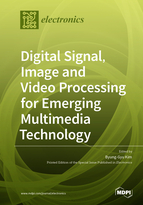Digital Signal, Image and Video Processing for Emerging Multimedia Technology
A special issue of Electronics (ISSN 2079-9292). This special issue belongs to the section "Computer Science & Engineering".
Deadline for manuscript submissions: closed (30 June 2020) | Viewed by 99017
Special Issue Editor
Interests: deep learning; multimedia processing; visual intelligence; emotion recognition
Special Issues, Collections and Topics in MDPI journals
Special Issue Information
Dear Colleagues,
Recent developments in image/video-based deep learning technology have enabled new services in the field of multimedia and recognition technology. The technologies underlying the development of these recognition and emerging services are based on essential signal and image processing algorithms. In addition, the recent realistic media services, mixed reality, augmented reality and virtual reality media services also require very high-definition media creation, personalization, and transmission technologies, and this demand continues to grow. To accommodate these needs, international standardization and industry are studying various digital signal and image processing technologies to provide a variety of new or future media services.While this Special Issue invites topics broadly across the advanced signal, image and video processing algorithms and technologies for emerging multimedia services, some specific topics include, but are not limited to:
- Signal/image/video processing algorithm for advanced machine learning
- Fast and complexity-reducing mechanisms to support real-time systems
- Protecting technologies for privacy/personalized information
- Advanced circuit and system design and implementation for emerging multimedia services
- Image/video-based recognition algorithms using deep neural networks
- Novel applications for emerging multimedia services
- Efficient media sharing schemes in distributed environments
Prof. Dr. Byung-Gyu Kim
Guest Editor
Manuscript Submission Information
Manuscripts should be submitted online at www.mdpi.com by registering and logging in to this website. Once you are registered, click here to go to the submission form. Manuscripts can be submitted until the deadline. All submissions that pass pre-check are peer-reviewed. Accepted papers will be published continuously in the journal (as soon as accepted) and will be listed together on the special issue website. Research articles, review articles as well as short communications are invited. For planned papers, a title and short abstract (about 100 words) can be sent to the Editorial Office for announcement on this website.
Submitted manuscripts should not have been published previously, nor be under consideration for publication elsewhere (except conference proceedings papers). All manuscripts are thoroughly refereed through a single-blind peer-review process. A guide for authors and other relevant information for submission of manuscripts is available on the Instructions for Authors page. Electronics is an international peer-reviewed open access semimonthly journal published by MDPI.
Please visit the Instructions for Authors page before submitting a manuscript. The Article Processing Charge (APC) for publication in this open access journal is 2400 CHF (Swiss Francs). Submitted papers should be well formatted and use good English. Authors may use MDPI's English editing service prior to publication or during author revisions.
Keywords
- Emerging multimedia
- Signal/image/video processing
- Real-time systems
- Advanced machine learning
- Image/video-based deep learning






